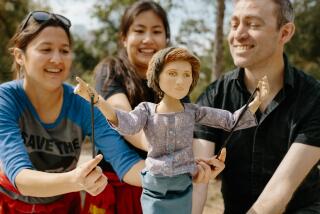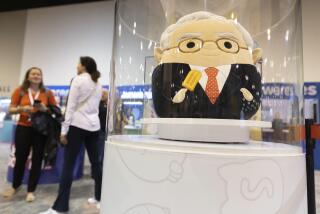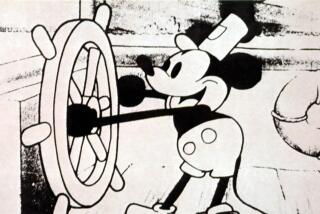Ken Forsse dies at 77; Teddy Ruxpin creator brought toy bear to life
Talking toys have been around since at least 1960, when pull-the-string Chatty Cathy debuted. But Teddy Ruxpin, a cuddly teddy bear that hit stores in late 1985, marked a technological leap forward.
Created by then-Granada Hills resident Ken Forsse, the talking Teddy moved his mouth in sync, making him seem much more lifelike. The effect was both delightful and a bit creepy, and kids loved him.
“1986 and 1987 were insane; you could hardly find Teddy Ruxpin in stores, it was so popular,” said toy expert Jim Silver.
Forsse, 77, died March 19 at home in Laguna Woods. The cause was congestive heart failure, said Josh Isaacson, a friend of the family who has long maintained a Teddy Ruxpin tribute website.
Teddy’s reign as the top toy was relatively brief, ending in a mire of financial and legal troubles. But the gentle bear who told storybook adventures was instrumental in sparking a new category for the toy industry — electronic plush. He still crops up in pop culture references on movies and TV shows. And he still has ardent fans.
“The slogan they used to advertise Teddy, ‘A friend for life comes to life,’ described aptly the friendship Teddy Ruxpin made with millions of children,” Isaacson said.
Forsse was born Sept. 17, 1936, in Bellwood, Neb., but his family moved when he was a child to Southern California. He graduated from Burbank High School and teamed up in the late 1950s with others to develop a children’s TV show starring puppets. “My job on the pilot was to sculpt and cast the latex puppet characters and build the settings,” Forsse said in a 1999 interview with Isaacson.
The pilot didn’t sell, but he began forming ideas for a character that decades later became Teddy Ruxpin. In the meantime he worked at the Walt Disney Co. on various jobs and for the Sid & Marty Krofft company that produced TV shows starring puppets. Forsse also served three years in the Army.
In the early 1980s he developed technology for animated puppets. Teddy Ruxpin had a cassette player built into his back where specially designed tapes provided audio and drove motors in the doll’s head to make facial movements. A deal was struck with the Silicon Valley company Worlds of Wonder to produce and sell the doll.
Silver, who now heads the toy review site TTPM, said he saw a prototype back then. Like many in the industry, he didn’t think much of it. “A lot of people were laughing at it,” he said. “A teddy bear with a cassette tape in the back? C’mon.”
But Teddy Ruxpin, at a premium price of $70 that included read-along storybooks, was a hit almost from the start. Silver said it came out at a time when it was increasingly common for both parents to have jobs, cutting into time spent with the kids. “And what parent wouldn’t like a teddy bear that would read along with a child?” The bear racked up an impressive $93 million in sales in a year and a spun-off daily animated TV show, “The Adventures of Teddy Ruxpin,” ran for 65 episodes.
But by 1987, the enterprise was coming off the rails. Worlds of Wonder, which had other toys on its roster, was in serious debt and eventually filed for bankruptcy. Forsse’s Chatsworth company, Alchemy II, had troubles of its own, with lawsuits flying over intellectual property and charges of management missteps. In the meantime, competitive talking toys were coming onto the market.
Production of Teddy Ruxpin halted and although several attempts were made at reviving the toy, none found much success. Forsse, who was far more involved with the creative side of the toy rather than management, went on to other ventures, but none approached the success of Teddy Ruxpin.
Still, the bear is a touchstone, for better or worse. This year he was featured in a “Jimmy Kimmel Live!” skit. And on the “SI Now” online sports show, actor Anthony Mackie used the term “Teddy Ruxpin” to describe a football player he didn’t think was sufficiently aggressive.
There were reports that Forsse was upset with the 2012 film “Ted,” which features a foul-mouthed teddy bear, though Isaacson said Forsse’s supposed objections were blown far out of proportion. In the movie, the main human character, played by Mark Wahlberg, says, “I think back to that Christmas morning and I wish I’d just gotten a Teddy Ruxpin.”
Forsse is survived by his wife, Jan; daughter Theresa Eversole; and son Christopher.
More to Read
Start your day right
Sign up for Essential California for the L.A. Times biggest news, features and recommendations in your inbox six days a week.
You may occasionally receive promotional content from the Los Angeles Times.







